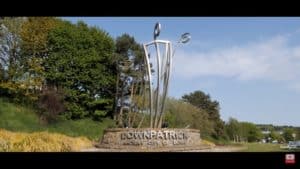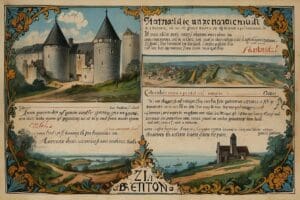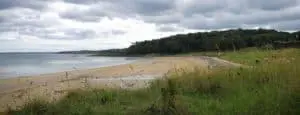The Poets of Ancient Ireland: Unveiling the Role of Ollamhs and Filí in Celtic Society
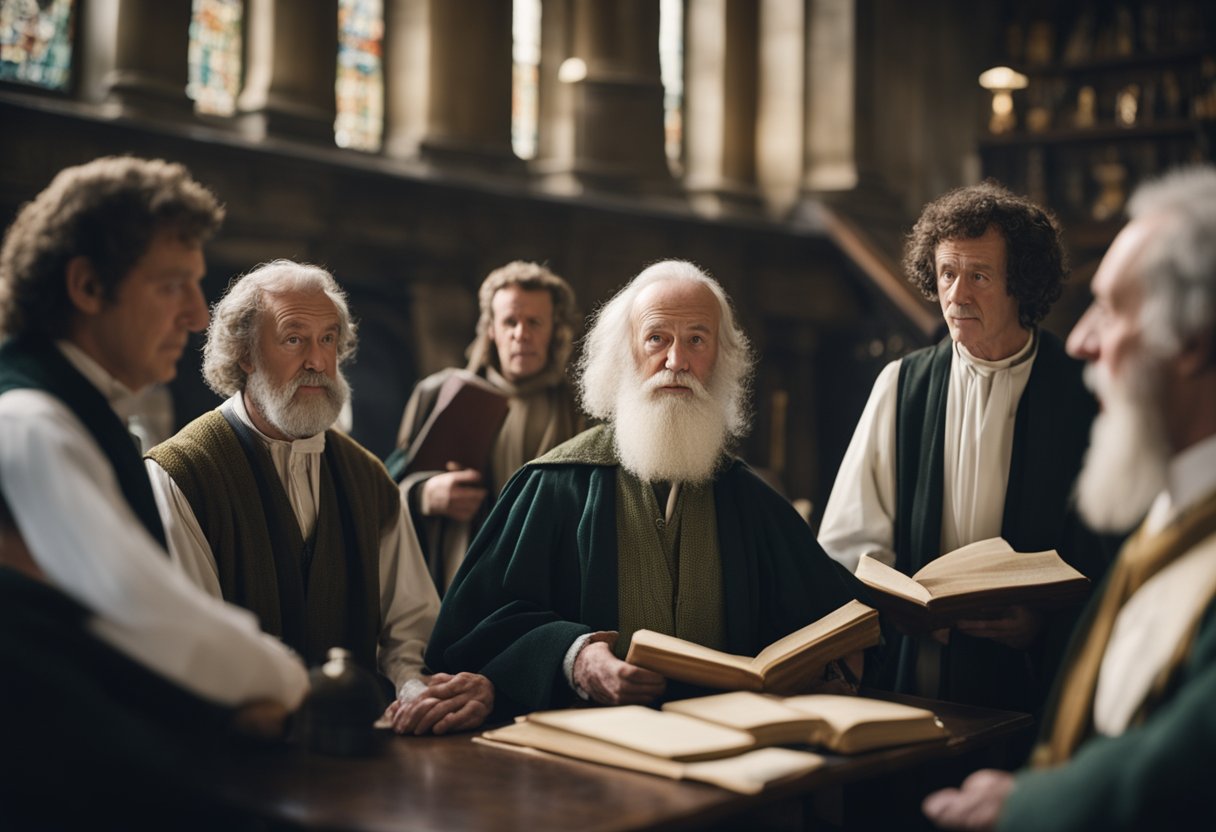
Updated On: April 24, 2024 by Maha Yassin
In ancient Ireland, the poets, known as Ollamhs and Filí, were custodians of a rich oral tradition that wove together the threads of our ancestry, mythology, and history. Their esteemed position in society was born from their profound knowledge and the creative artistry with which they chronicled the tales of the land and its people. These professional poets held a unique blend of roles, from preserving genealogies to composing and reciting poems that celebrated and critiqued the ruling class. Their influence extended beyond mere storytelling; they were key figures in maintaining the cultural and political fabric of the communities they served.
The education and training involved in becoming an Ollamh or a Filí were arduous and meticulous, ensuring that only those with true dedication and talent rose to prominence. Through their poetry, which came in various forms, they captured the spirit of Ireland, reflecting the beauty and complexity of the society they lived in. Their work entertained and served important legal and judicial functions, further underlining their indispensability. As carriers of knowledge and advisers to the elite, these poets played an indispensable role in articulating and preserving social values and historical continuity.
The Societal Role of Poets of Ancient Ireland
In Ancient Ireland, poets, known as filí and bards, held significant societal positions, influencing culture and politics. These literary figures were custodians of history and tradition and key players in the social hierarchy.
Ollamhs: The Highest Rank of Poets
Ollamhs, or ollamhs, represented the pinnacle of the poetic profession. They served as chief poets and intellectuals within the Gaelic social order. Comparable to modern-day scholars, they held a status akin to the nobility. An Ollamh could be a counsellor to the High King himself, and this role extended beyond the mere composition of poetry to encompass the duties of a seer and judge. Their words carried immense weight and contributed significantly to the education and continuation of Gaelic cultural practices.
The Filidh and Bards: Seers and Storytellers
Below the ollamhs were the filidh and bards, named respectively for their prophetic vision and storytelling prowess. The filidh, in particular, were revered as visionaries or seers, often associated with monasteries, and could ascend through seven learning grades. Though of a lower grade than filidh, Bards still commanded respect for their lyrical narratives that preserved the myths and history of Gaelic Ireland. The filidh and bards formed a vital link to the Celtic past, weaving political commentary and societal values into their works.
Patrons and Patronage: The Relationship with Nobility
Patronage was the lifeblood of the poet in Gaelic Ireland. Poets were often sponsored by patrons from the nobility, cementing a reciprocal relationship where poets provided praise and legitimacy to their patron’s lineage and deeds while receiving protection and financial support in return. This system allowed poets to develop their craft and elevated their status within the court and among the common people. As the voice of both the ancestors and contemporary society, they upheld the traditions and enforced the social norms of their time.
By fulfilling these roles, poets, ollamhs, and filidh were integral to the fabric of ancient Irish society, acting as custodians of knowledge and heralds of the cultural identity of their time.
Education and Training of Poetic Grades
In ancient Ireland, poets were revered members of society, earning their status through extensive study and practice. Let’s explore the structured education and grading system that produced these esteemed figures of Irish culture.
The Rigorous Path to Becoming an Ollamh
One underwent a rigorous educational journey to achieve the highest grade of Ollamh. Initially, a student entered as an apprentice and gradually advanced through a series of grades, each requiring several years of dedicated study and mastery of complex oral traditions. The path involved comprehensive learning of history, law, genealogies, and the art of composing poetry.
Schools of Learning and Literary Instruction
The prestigious learning schools in ancient Ireland were akin to centres of excellence where the literary arts flourished. Here, students pursued their studies in structured environments for up to twelve years or more to reach the highest grade. Each school adhered to strict pedagogical standards, ensuring the literary tradition was preserved and expanded with every new generation of Ollamhs and Filí.
Ancient Irish Poetry and Its Forms
Ancient Irish poetry stands as a testament to early Ireland’s intellectual and cultural richness. Its intricate forms and functions reflect a society deeply connected to its history, nature, and spiritual life.
Techniques and Metres in Early Irish Literature
The poets of ancient Ireland, known as ollamhs and filí, were masters of complex poetic forms. Their art involved a variety of metres, which required strict adherence to syllable counts and intricate rhyme schemes. Examples of these metres include Deibhidhe and Rannaigecht, with the latter sometimes consisting of quatrains of seven-syllable lines intricately rhymed. Literature from this period reveals that these forms served not only to entertain but also to remember history and laud the deeds of patrons.
Nature Poetry and Secular Verses
Nature poetry emerged as a significant genre reflecting the intertwined relationship between the Irish people and their land. Verses often personified natural elements, celebrating the beauty of Ireland’s landscapes and seasons. Secular poetry also flourished, capturing everyday life, love, and the social order. It was through these stories and poems that the Celts expressed their connection to both their surroundings and to the complexity of human emotions.
Spiritual and Monastic Contributions
With the advent of Christianity, monasteries became centres of learning and literary production. Monks and religious scholars contributed to the canon of early Irish literature, often blending Christian themes with the traditional Celtic worldview. This resulted in a body of work that included devotional verses, reflective musings, and didactic poetry, pivotal in preserving both spiritual teachings and the linguistic heritage of early Irish culture.
Cultural and Religious Dynamics
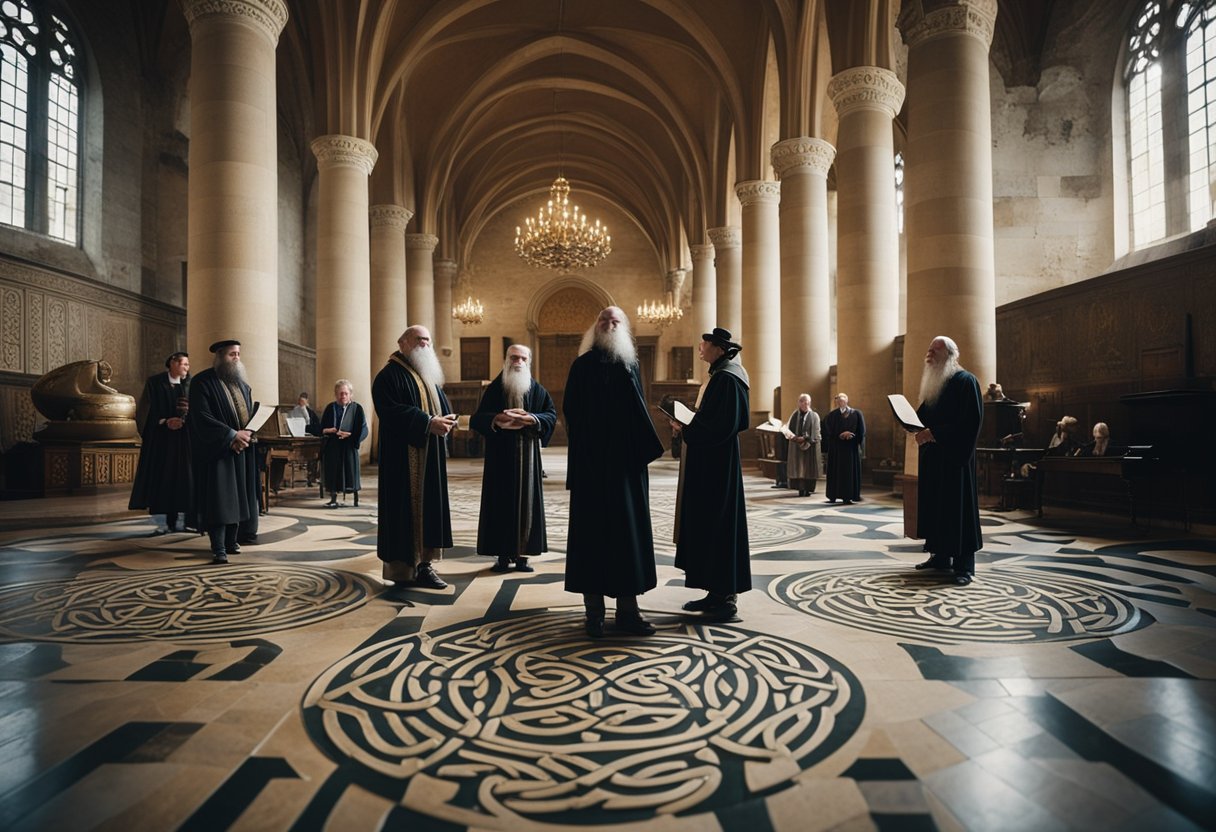
In examining the poets of ancient Ireland, it is crucial to understand how the intertwining of religious beliefs and cultural practices influenced their roles. This section delves into how Paganism was gradually fused with Christianity and the part played by monastic scribes and religious leaders in preserving oral traditions.
The Intersection of Paganism and Christianity
Before the spread of Christianity in Ireland, Druids held significant religious and cultural influence. As the chief spiritual figures, they performed rites and preserved traditions. With the arrival of Christianity, these indigenous beliefs did not vanish overnight; instead, they were progressively merged with Christian practices. This fusion created a unique religious landscape where Christian monks and Druids sometimes cooperated, resulting in a rich tapestry of intertwined lore and spiritual traditions.
Monastic settlements became centres for learning, influenced by both Druidic traditions and Christian teachings. Our poets, the ollamhs and filí, found that their roles, once occupied by druids, evolved within this new framework. They adapted to include Pagan and Christian narratives, making them indispensable preservers of Ireland’s historical and cultural legacy.
Monastic Scribes and Religious Leaders
The monks in the monasteries were indispensable in the transition from oral to written culture. They acted as religious leaders and monastic scribes, painstakingly transcribing lore and verses that generations of ollamhs and filí had orally recited. These scribes copied Biblical texts and secular poems, annals, and histories, securing the continuation of Irish traditions.
We observe that the symbiotic relationship between the monks and our poets was grounded in a shared dedication to preserving knowledge. Monastic schools, where many filí were educated, became repositories of spiritual teachings and cultural narratives. By capturing these narratives, religious leaders ensured that Irish heritage, with its diverse influences and traditions, was not lost to time.
Preservation of History and Genealogies
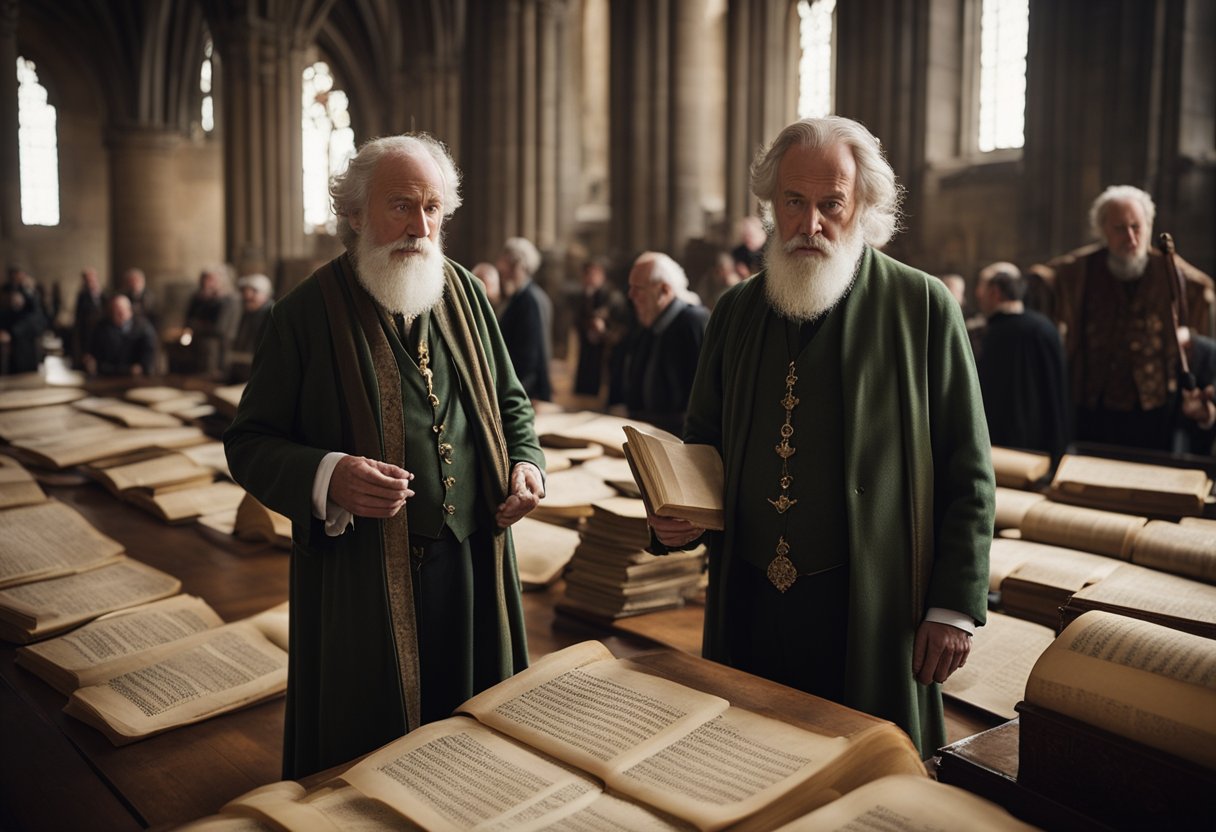
The ancient Gaelic poets, known as Ollamhs and Filí, were instrumental in conserving the rich tapestry of Ireland’s past. Their meticulous work in recording and preserving genealogies and historical narratives was essential for the continuity of Gaelic Ireland’s cultural heritage.
Role in Recording Ancient Gaelic Lineages
As the esteemed poets and scholars of their time, Ollamhs was responsible for chronicling the lineages of Gaelic nobility. Through their composed poems and prose, they meticulously documented genealogies, ensuring that the heritage and connections of Irish clans were preserved for posterity. Often, they committed these to memory and inscribed them onto manuscripts, thereby safeguarding the information within an oral and written tradition.
This dedication to maintaining historical accounts was not merely an artistic endeavour but a societal duty to uphold the continuum of Gaelic Ireland’s identity. These records provided insights not only into familial heritage but also into the socio-political structures that underpin Gaelic society.
Furthermore, the Ollamhs and Filí crafted comprehensive accounts of events that shaped the cultural landscape. Their contributions are evident in the survival of various manuscripts that contain a people’s collective memory and history. These texts are a testament to the rigorous standards upheld by these poets, reflecting a tradition that valued accuracy and detail in retelling past genealogies and histories.
Through their dedication to the preservation of information, the Ollamhs and Filí played an indispensable role in the cultural fabric of Gaelic Ireland, embodying the respect for ancestral knowledge that we continue to honour. Their works remind us of Irish culture’s deep roots and persistent spirit.
Legal and Judicial Functions
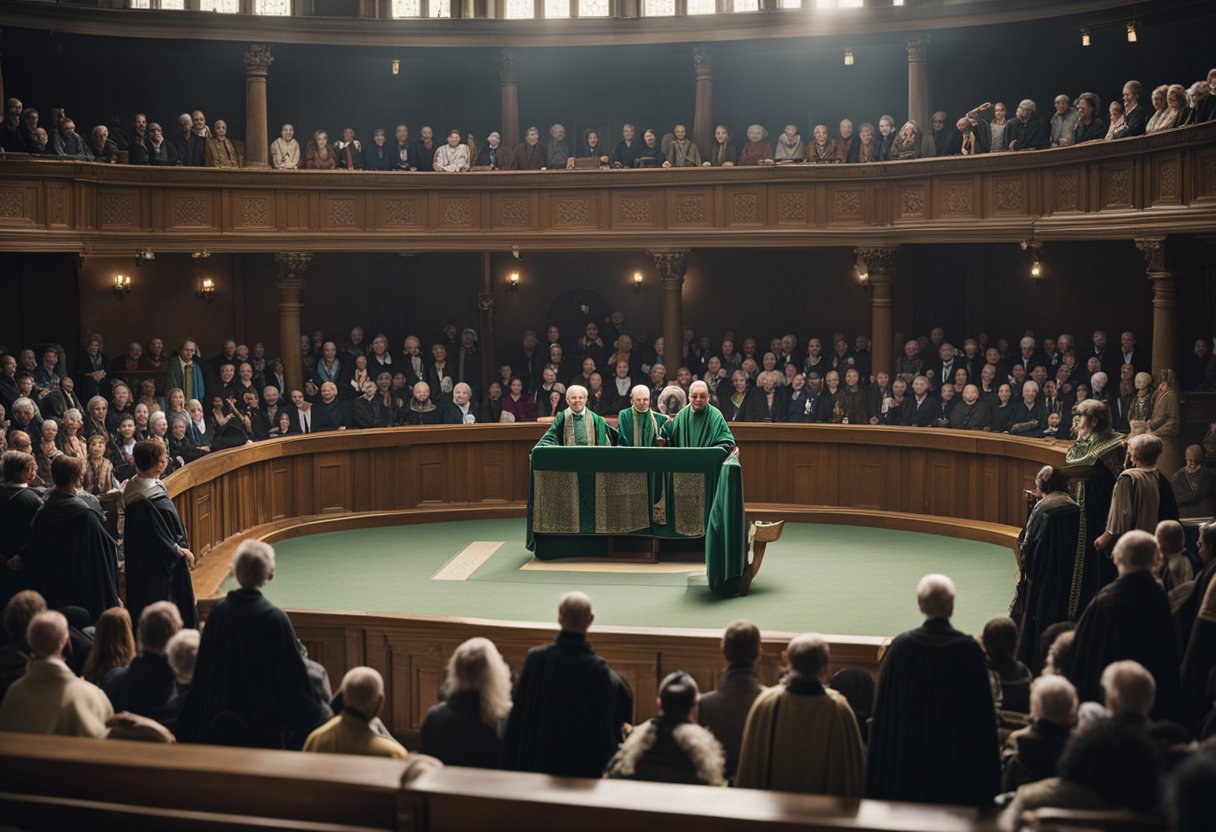
In ancient Ireland, the poets, known as Ollamhs and Filí, were integral to the legal and judicial system, serving as cultural custodians, legal authorities, and interpreters.
Brehon Law and the Poetic Elite
Under Brehon Law, the Ollamhs (learned poets) were esteemed members of society with roles extending beyond their poetic arts. Brehon Law comprised a sophisticated legal system which included property rights, divorce, and restitution, among other civil matters. These laws did not rely on a state-enforced penal system but on societal enforcement, compensation, and honour.
The Ollamhs were often part of a hereditary class, typically aligning themselves with specific dynasties or territories. Due to their extensive knowledge of history and traditions, they held the prestigious position of being advisers to rulers. They were pivotal in the interpretation and preservation of law and justice.
Filí as Judges and Law Interpreters
The Filí, akin to the Ollamhs, held a wisdom-rich status amidst the Gaelic social hierarchy and fulfilled roles as judges and law interpreters. Exceptional in the composition of poetry, they, too, were esteemed for their deep understanding of legal intricacies.
Despite not being legal professionals in the narrow modern sense, the Filí’s prowess in knowledge meant their judgements and advice were often sought in legal disputes. As custodians of societal norms and values, they contributed significantly to legislative processes, and their decrees influenced the communal perception of justice.
As law interpreters, the Filí would often be present during legal proceedings, providing insights into customary law and precedent. Through the power of their word, they helped navigate complex legal principles and ensured that a blend of legal scholarship and societal ethos guided justice.
Symbolism and Regalia of Poetic Office
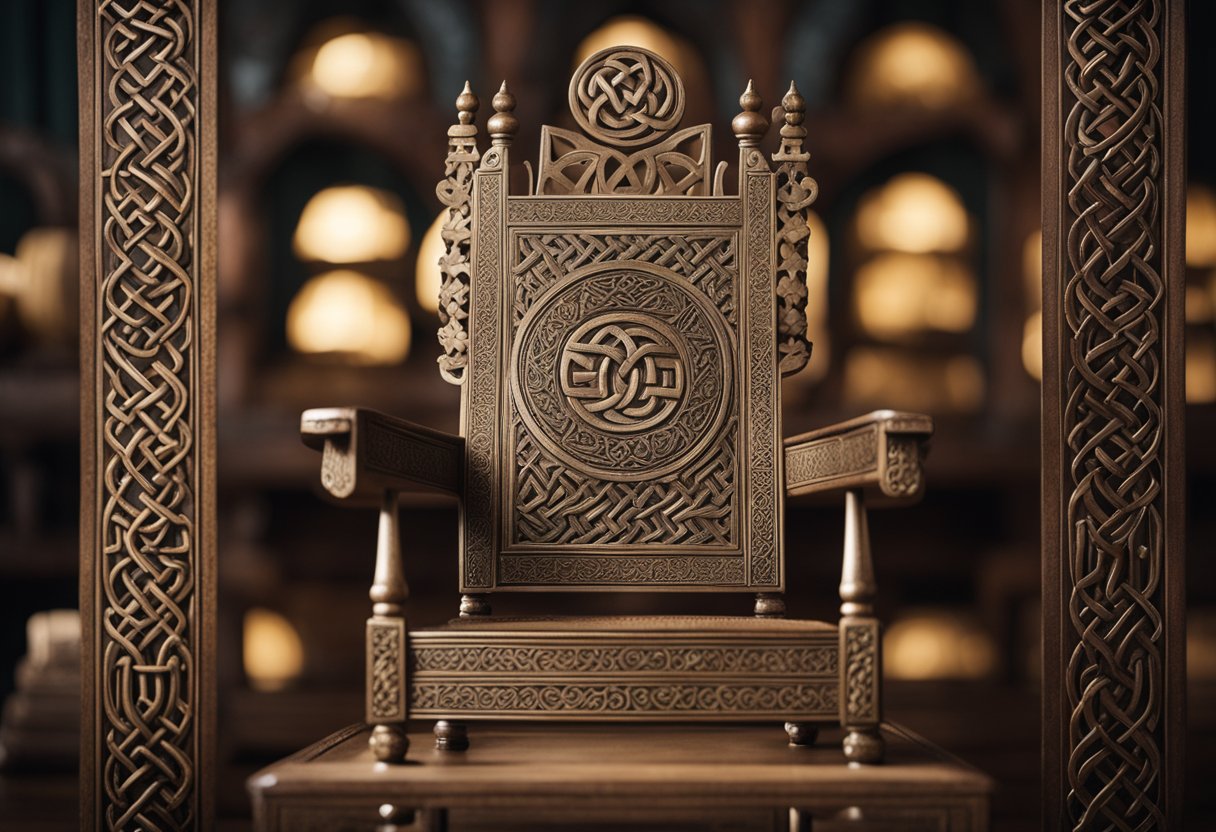
In ancient Ireland, the office of the poet, or ollamh, was distinguished by significant symbols and regalia that denoted their esteemed position within society.
The Wand of Office
The Wand of Office, or slat, was a hallmark of the ollamh, carrying deep symbolic weight. This slender rod, typically made of yew, represented its holder’s authority and learned status. An ollamh wielding this wand was recognised as an official poet, commanding respect equivalent to a chieftain or king within the social hierarchy. It signalled the right to speak and the wisdom imparted with the expectation that others would listen.
Crimson Bird Feathers
Crimson bird feathers were not merely decorative but potent symbols of the ollamh’s role. These feathers, often obtained from rare and prized birds, were attached to their clothing and sometimes part of the headgear, reflecting the exalted status of the poet. The rich crimson hue was associated with nobility and learning, and including such feathers in their attire set them apart from others, visually reinforcing their high rank and cultural importance.
Oral Tradition and Performance
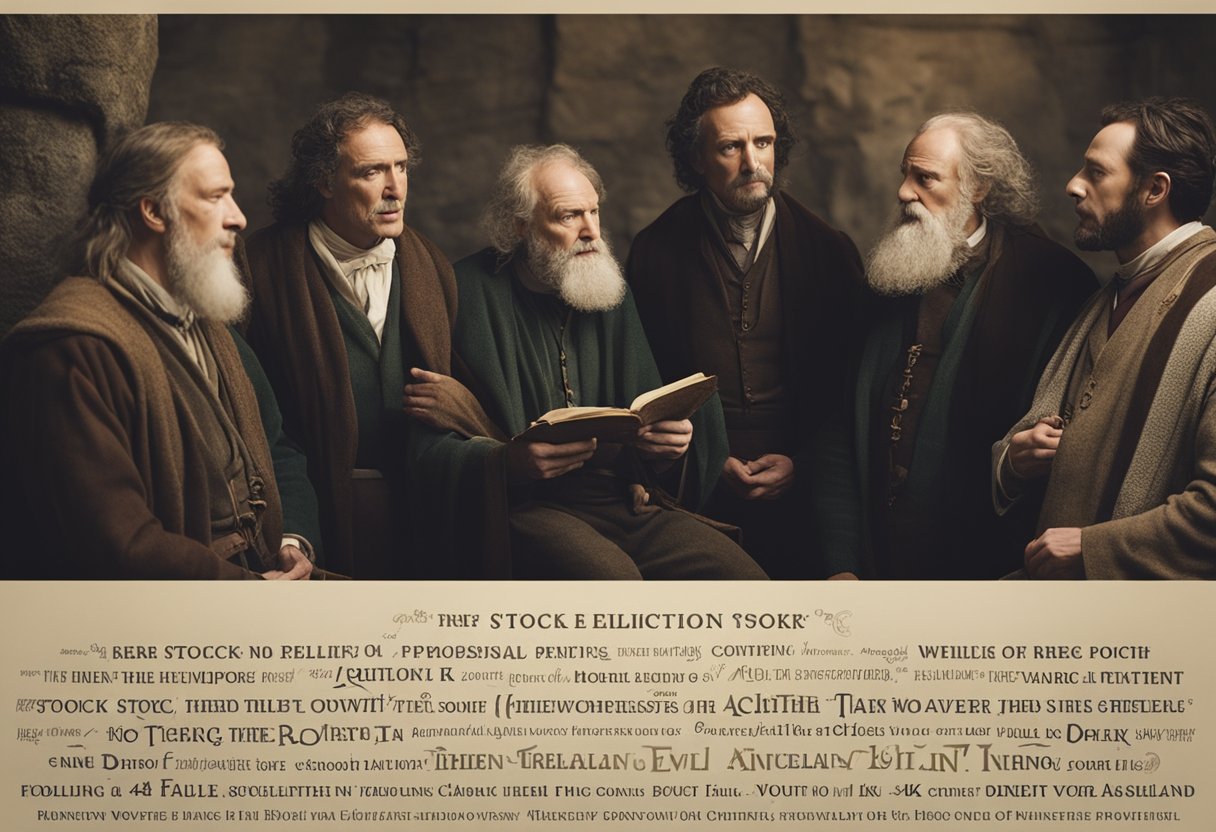
Before delving into the specific practices, it’s crucial to understand that the oral tradition in ancient Ireland wasn’t just about storytelling; it was a highly structured performance art deeply integrated within the societal and cultural framework of the time.
The Bardic Performance and Music
Bards were esteemed within the court as custodians of tradition and history, expected to perform more than just a recitative role. They utilised music as a pivotal part of storytelling, turning tales of heroes and the histories of clans into enthralling performances. The bards’ expertise in recitation was complemented by complex mnemonic devices and formulaic expressions that ensured accuracy and flair in their delivery.
Harping Tradition and the Filidh
Similarly important to the oral tradition was the harp, one of Ireland’s most celebrated musical instruments today. The filí, akin to the bards, were revered poets who often accompanied their recitations with the harp. This instrument played a central role in the performance, setting the rhythm of the narrative and providing dramatic emphasis to the tales spun by these skilled poets. The interplay between spoken word and harp created an immersive experience integral to Irish courtly life’s fabric.
Literary Forms of Satire and Lampoon

Satire and lampooning have significantly shaped societies by critically examining and ridiculing social norms, politics, and individuals. These literary tools carry the weight of influence and consequence, as demonstrated by the practices of the ancient Irish poets.
The Power of Poetic Satire in Society
In ancient Ireland, the fili were esteemed poets whose words could uplift or devastate. Their satires were more than mere poems; they were potent instruments that could tarnish reputations and sway public opinion. Such was the power of the fili’s satirical verse that it was feared by nobles and kings alike, for it could erode the generosity and honour that were the pillars of their status in society.
Consequences of Political and Personal Lampoons
Lampoons, often more personal and biting than broader satire, could incite serious implications for both the subject and the creator. A well-aimed lampoon could disastrously impact the reputation of its target, wielding humour and irony as weapons. However, for the fili, crafting a lampoon against someone powerful could lead to retribution or loss of patronage, thus jeopardising their standing and livelihood.
Transformation of Poetic Tradition Over Centuries
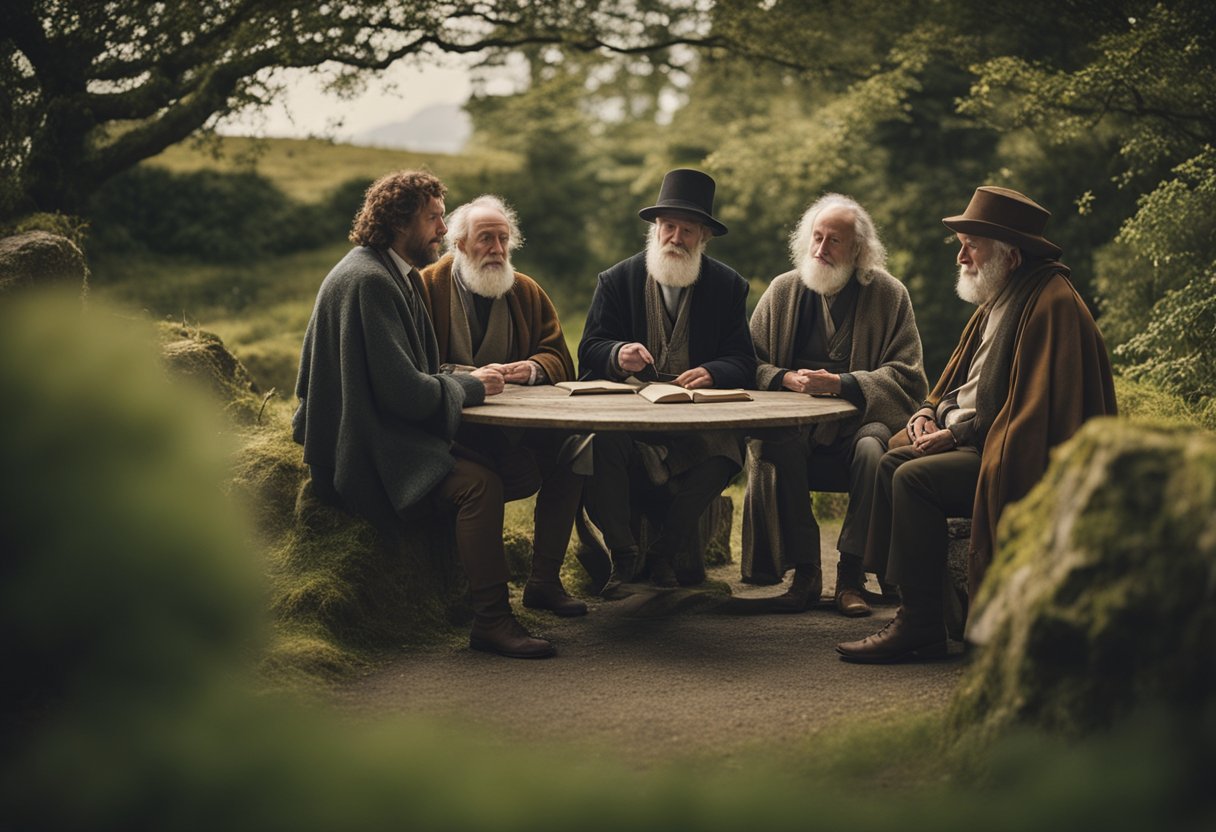
The Irish poetic tradition has changed significantly from its early roots in Gaelic Ireland to the dramatic transformations of the 17th century and beyond. Our discussion will trace how Irish poets, the filidh, adapted to cultural shifts and linguistic changes.
From Gaelic to Elizabethan Times
In Gaelic Ireland, our language and culture were strongly interconnected with the esteemed position of the filidh. These skilled poets were guardians of history, genealogy, and literature, performing their works orally in a society where such skills were revered. However, as the Tudor conquest of Ireland progressed, bringing with it the influences of Elizabethan times, the role of the filidh began to wane. The political and social upheaval caused a gradual shift from the traditional Gaelic order to an English-oriented system.
This transition marked a point of linguistic and cultural change, where the Irish language slowly receded in the face of English dominance. Yet, the filidh did not disappear overnight. Instead, they found themselves in an evolving society where their roles and the reception of their art form needed to adapt to the new cultural landscape.
Poets sometimes transitioned their craft to accommodate the English language and new societal norms. While the core of the poetic tradition—its deep connection with Irish identity—remained intact, its expression began to transform to mirror the changing times.
The Seventeenth Century and Beyond
Moving into the 17th century, our poetic tradition faced further challenges and transformations. The disruption of the traditional Gaelic social structure – where filidh were integral to the community – led to a new reality for Irish poets. Social confusion and the drastically altered political environment of the seventeenth century resulted in a complete overhaul of the patrons and platforms available to the filidh.
As the century progressed, we witnessed the filidh adapting again, turning to a more European-influenced style of writing that used the printing press. This technology forever changed how poetry was disseminated and consumed. The oral tradition that once defined Irish poetry began giving way to the written word, allowing a wider and more varied audience to access the craft.
With this shift came a new wave of Irish poets who embraced the English language, while others sought to preserve the essence of the Gaelic tradition within their work, even if using English to do so. This period was pivotal, as it marked the beginning of a bilingual poetic practice that would pave the way for future generations to explore and express Irish cultural identity through poetry in both Irish and English.
Frequently Asked Questions
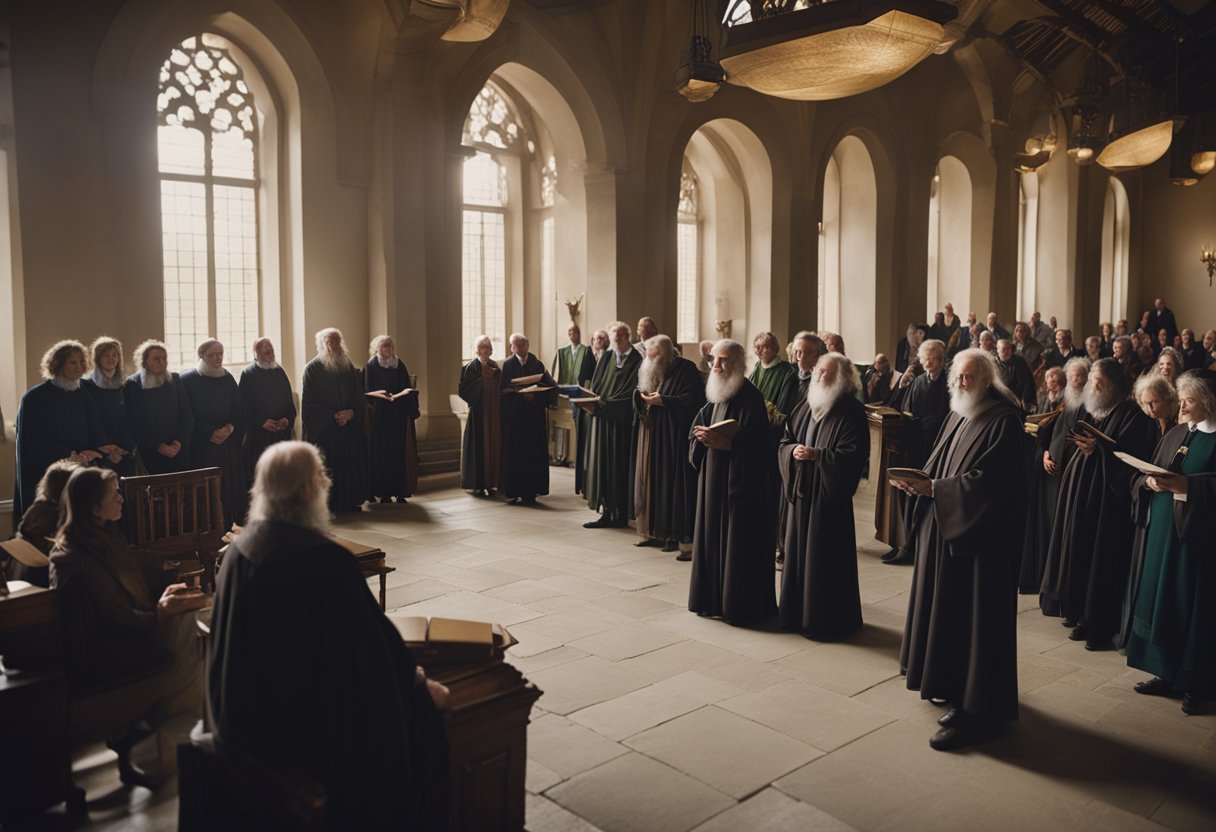
In exploring ancient Irish society, we encounter the esteemed figures of Ollamhs and Filí. These individuals were the custodians of culture, history, and the art of poetry. Their contributions were pivotal in preserving the Gaelic tradition and providing insight into the everyday life and beliefs of the Celts.
Who were the Ollamhs and Filí within ancient Irish society?
Ollamhs served as the most prestigious poets in ancient Ireland, holding a status comparable to that of nobility, while Filí were revered for their craftsmanship in verse and prose. These poets were integral to cultural preservation and counselled the ruling classes.
What role did poets play in Celtic culture?
The poets of ancient Ireland, Ollamhs and Filí, were much more than mere entertainers. They were historians, genealogists, and important figures in the education and governance of the time, often involved in the political sphere and the administration of law.
Can you describe the attributes of traditional Irish poetry?
Complex metre schemes, alliteration, internal rhyming, and a deep connection with nature characterise traditional Irish poetry. It dealt heavily with themes of heroism, history, and mythology, maintaining the cultural narratives of the Gaelic people.
Which renowned Irish poet is associated with the ancient Gaelic era?
Perhaps the most highly-regarded poet from the ancient Gaelic era is Amergin Glúingel, whose legendary incantations and poems have become a significant part of Ireland’s mythological heritage.
How do you pronounce ‘Filidh’, and what does it signify?
‘Filidh,’ pronounced as [FIL-ee], refers to the poet-scholars of ancient Ireland who were revered for their knowledge and mastery in creating poetry and preserving the culture’s oral history.
What is the historical significance of Druids in Ireland?
Druids were members of the high-ranking professional class in ancient Celtic cultures, and in Ireland, they were seen as priests, legal authorities, lore-keepers, medical professionals, and political advisors. Their significance lies in their role as the preservers of lore and spiritual practices, as the bridge between the natural and the divine.




